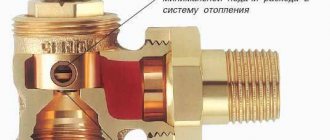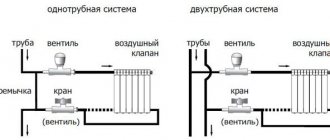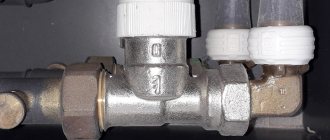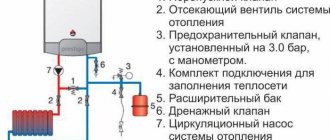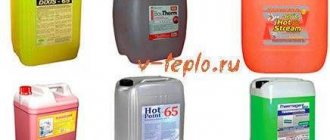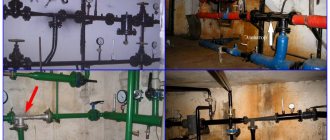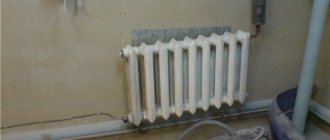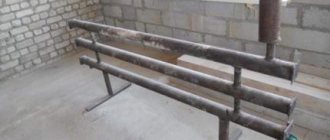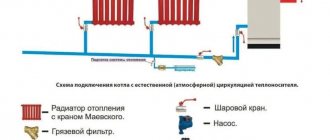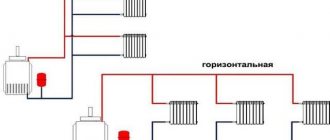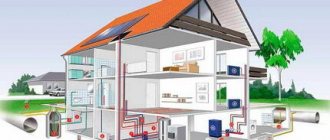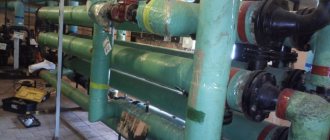To regulate the flow of water, other liquids and gas in process pipelines and water and gas transmission structures, various types of hydraulic systems and mechanisms, control, as well as shut-off and control valves and devices for regulating and maintaining system parameters are used. This type of fittings can be classified as technical devices, the operation of which allows you to perform operations to shut off the flow, regulate, mix flows, and also allows you to change the area (diameter) of the design cross-section of the pipeline within the required parameters.
The used control and shut-off equipment, blocking completely or partially, distributing the hydraulic flow, ensuring mixing of the flowing working fluid and gas, allows you to regulate several parameters in the system. This includes equalizing and regulating pressure, pressure, volume, and in some cases the temperature of the liquid can be adjusted.
Shut-off valves are components of hydraulic and gas systems used in level sensors and flow meters, as well as in industrial installations and general purpose pipelines, used in the construction of hydraulic systems of residential and public buildings and industrial facilities. Shut-off valves for pipelines, when used, allow, first of all, to stop the flow of working fluid or gas, which is why it got its name. The shut-off valve is not used (not recommended for use) as a control valve to regulate flow; mixers, control valves, throttles and other types of process control devices are used for this purpose. Depending on the shape, purpose, design, purpose of use, shut-off valves can perform the function of shut-off and control.
What types of shut-off valves for heating are there - types, characteristics
When installing heating in private households, multi-apartment buildings and to organize the operation of central heat pipeline systems, shut-off and control valves for heating radiators and systems are used. It is installed in the circuit, which ensures the highest heating efficiency and its economy.
How do shut-off and control valves work?
In most cases, shut-off and control valves find their work on pipelines where control of the volume of hot and cold water supply and pressure in the system is required. The faucet usually has a handle that moves a quarter turn less than half a turn to easily switch from the open position to the closed position when performing tasks such as repairing leaks or performing other repairs.
For valve devices, it is necessary to turn the operating flywheel or wheel several revolutions around the axis until the locking mechanism rests on the seat and blocks the flow. Shut-off valves do not provide much control over water flow or pressure, which is maximum in the open position. Shut-off valves are located between the source, the central distribution point of water (gas) in a house or other building and the distribution system inside a separate room.
Shut-off valves are used as flow shut-off devices; they provide shutoff of flow. They are installed before and after elements such as: boiler, pumps, filters, heat exchangers, domestic hot water tanks, underfloor heating distributors. In addition, these installations have special shut-off valves that are perfectly shaped for use (straight or angled) which allow any radiator to be switched off during maintenance or repairs without affecting other radiators in the central heating installation.
Types of shut-off, control and shut-off and control valves
- Cranes. Most often, standard water taps range from three-eighths to one and a half inches in diameter. Usually these are ball valves or valves at the entrance to the apartment or separate rooms.
- Gates (valves). They are used in the same place as taps, but can also be installed on pipes with a diameter of up to one and a half to two inches, and can be installed on intra-house distribution networks.
- Valves are devices for use on main pipelines with a diameter of two inches or more.
- Dampers. They are used on main pipelines for hot and cold water supply and heating.
The type of shut-off and control valves that provide regulation of the states of the working environment, flow rate, specified by technological conditions and parameters, as well as to maintain the required system pressure within design limits is called control valves.
It could be:
- a control valve capable of decreasing or increasing the flow of liquid or gas;
- a shut-off and control valve, which, in addition to regulation, can ensure complete locking of the system;
- a mixing valve that can provide mixing of several flows in a given proportion;
- direct acting pressure regulator, a device that is used when it is necessary to accurately regulate or maintain system pressure;
- a liquid or gas level regulator, most often with feedback on the flow level or other parameters.
Purpose and selection of shut-off valves
For heat supply systems, this fittings are used to control the supply of hot coolant and turn off the power to the heating circuit. Basically, a shut-off valve is installed on a heating device in areas where heating devices are connected with pipelines.
A similar solution, in addition to its practical positive qualities, has functional benefits. After closing the shut-off valve of the battery, the home repairman will have the opportunity to repair it without stopping the functioning of the entire heating structure.
At this time, shut-off valves for heating are offered in a wide range on the market in our country, and among the very commonly used products are these devices:
- shut-off valves;
- valves;
- needle valves;
- ball valves.
All of them are made from strong metals that are resistant to corrosion and high temperatures. Shut-off valves protect the heating circuit from the possibility of a dangerous situation, increases the reliability of the heating network, thus helping to minimize the bad consequences resulting from a malfunction of a separate heating device.
Purpose of shut-off plumbing
Shut-off valves are designed for manual regulation of coolant supply
In heat generation systems, shut-off type fittings act as a regulator of the flow and movement of coolant, and also allow the heating circuit to be opened. In this case, the heating process becomes controlled, its rationality and efficiency increases.
The shut-off valve is most often installed at the interval in the line where the battery is connected with pipelines. This technique allows you to adjust the heating of the radiator and facilitates the task of maintaining and repairing the heater without the need to turn off the entire heating circuit.
Ball valves
This product refers to shut-off valves for devices for heating a room. It is designed to regulate the flow of liquid, which is used as a coolant. A valve with a round hole consists of a union nut, an air release device, which is designed to bleed air from the system, and a plug. The product has an internal thread.
When purchasing this type of fittings, you need to look at the material of manufacture and the presence of o-rings that increase the service life of this element in the circuit. As practice shows, brass taps themselves are distinguished by their very high wear resistance and anti-corrosion resistance.
Shut-off valves
This type of shut-off valve is used to create the possibility of replacing a heating device without draining liquid for operation from the heat supply system. Taking into account the design features, straight and angular variations of such valves are distinguished.
Certain products are equipped with a drain mechanism prepared for a smooth decrease in pressure in the heating circuit. Shut-off valves are distinguished by the presence of a hose nozzle, which allows the installation process to be carried out as hassle-free and easy as possible.
Needle valves
The functions that a needle tap must perform are distinguished by their diversity. According to the structural device, such a product usually has a shut-off, regulating and balancing purpose.
The needle valve in heating systems is used for heating devices. Due to its presence, a smooth shut-off of the flow is ensured and it is possible to avoid the consequences of water hammer, which have a negative impact on the entire heat supply structure.
Unlike a ball valve, which has two positions, a needle valve can operate in three modes:
These fittings perform exclusively a locking function. Due to the design features of the valve, it is usually located exclusively in two positions, since the mechanism has a closing component located perpendicular to the flow of the coolant. If the valve component is in an open position, the heated liquid enters the circuit, and when it is closed, it does not allow it to circulate.
The valve has a number of special characteristics:
- Provides low hydraulic resistance in the circuit.
- It has a suitable diameter size inside, similar to the cross-section of the pipeline.
- It's easy to install.
- It stands out for its great reliability.
Shut-off valves for work in aggressive environments
The fittings, which are made from brass, are lightweight, but are able to function at high compression values. Its use allows us to guarantee 100% flow shutoff. If it is necessary to install shut-off devices on a pipeline that transports chemically aggressive media, such as acids or alkalis, then brass fittings are successfully used. It has a small mass, while being able to withstand strong compression. The tightness of brass fittings is ensured by bellows elements. For such valves, anti-corrosion resistance is very important, therefore, in systems with aggressive environments, flanged, diaphragm, and porcelain valves with a rubber coating are often used.
Ball valve STOUT with half fitting 1/2″ VR/HP butterfly brass
Shut-off and control valves
Apart from the locking function, which helps prevent dangerous situations in the circuit, the fittings usually perform the task of regulating the flow of coolant. Control valves for heating radiators and systems are used to smoothly adjust the temperature of the heated liquid, in order to stabilize the pressure, and also to control the direction of movement of the working environment.
These devices are demonstrated by the following types of valves: balancing; reverse; rechargeable; thermo-; waste; bypass
Balancing valve
During the installation of heating systems, it is used to regulate the operation of several hydraulic circuits. Installing a balancing valve makes it possible to increase the efficiency of the heating structure, as it helps control the possible volume of coolant consumed.
Properly installed, this type of fittings, whose operating principle is to distribute the heated liquid evenly across all segments of the heat supply system, can work in very difficult conditions. This device can withstand significant pressure drops in the circuits and high speeds of movement of the coolant through pipelines.
The balancing valve, the price of which for direct-acting modifications is not small, consists of the following important elements:
- housing made of steel, aluminum alloy or brass;
- pipe section;
- position lock;
- membrane septum;
- measuring diaphragm;
- shutter indicator.
Check Valve
The use of this type of control valve makes it possible to prevent water hammer and thereby helps to increase the reliability of the entire heating structure. The valve prevents reverse circulation of the heated liquid through the system. In order for the device to be acceptable in combination with the circuit, it must be selected taking into account the diameter inside.
The main element of a check-type valve is a spring, which serves to hold the rod and closes it if a dangerous situation occurs in the circuit.
Heating system installation
We will begin the description of installation work with the installation and piping of the boiler. In accordance with the rules, units whose power does not exceed 60 kW can be installed in the kitchen. More powerful heat generators should be located in the boiler room. At the same time, for heat sources that burn different types of fuel and have an open combustion chamber, it is necessary to ensure a good air flow. A chimney device is also required to remove combustion products.
The location where the heat generator will be located must be selected taking into account the minimum permissible distances to walls or other equipment. Typically these intervals are specified in the manual supplied with the product. If this data is not available, then we adhere to the following rules:
- passage width on the front side of the boiler is 1 m;
- if there is no need to service the unit from the side or rear, then leave a gap of 0.7 m, otherwise - 1.5 m;
- distance to the nearest equipment – 0.7 m;
- when placing two boilers next to each other, a passage of 1 m is maintained between them, and opposite each other - 2 m.
Make-up valve
To ensure effective circulation of the operating environment in the system, there must be a suitable volume of coolant in the circuit - water, antifreeze, etc. Thanks to this, the make-up device is one of the necessary elements of every heating structure.
This type of valve makes it possible to compensate for fluid losses resulting from leaks in heaters and the use of bleed valves and air vents.
The main purpose of this recharge element is to control the amount of coolant in the circuit, and if necessary, it should replenish its losses. It is best to choose an automatic device equipped with a reduction mechanism and a membrane fabric, which is located under the pressure of the working environment.
If the pressure in the circuit is reduced, the liquid does not affect the membrane tissue, the rod pushed by the spring falls, opening a gap in the seat. Eventually, the circuit begins to be fed from the water supply pipe until pressure is established in the system.
Thermal valve
It is considered the most effective control valve for heating radiators. This device increases the practicality of the circuit and makes the heating process simple, good, and most importantly, healthy. The thermal valve can be mechanical or automated. Products of the first type consist of thermal and valve.
Automated models have a more complex design; they consist of similar elements:
- temperature sensor - built-in or remote;
- programmer;
- automatic control systems.
An automated type mechanism is designed to regulate the temperature regime in the circuit in accordance with the settings that are pre-set by heat energy consumers. This device is sold at a high price, but it is fully justified, since with its help you can maximize the functioning of the heat supply system.
How to adjust the balancing valve in a heating system
Setting up a mechanical balancer
Before setting up the balance of the radiator network, you need to study the instructions for the valve, which are included when purchasing it. It indicates an adjustment scheme; if the user installs everything correctly, he can actually reduce the cost of thermal energy. The valve can be adjusted in two ways.
The first way to adjust the valve
This is the simplest and most proven adjustment option, which is recommended by experienced thermal regulators in water heating networks. To do this, you will need to divide the number of valve revolutions by the number of batteries installed in the heating circuit around the perimeter of the room. This technique makes it possible to correctly determine the step of the tuning algorithm. The method consists of closing all the valves in the reverse order - from the outermost to the first battery in relation to the heating source.
For example, for a dead-end circuit with 4 radiators equipped with mechanical balancing valves and a 4.5-turn spindle adjustment:
4.5:4 = 1.1 turns
Opening diagram:
- The first balancing valve is 1.1 turns.
- Second balancing valve – 2.2 turns.
- Third balancing valve – 3.3 turns.
- The fourth balancing valve is 4.5 turns.
The second way to configure the balancer
There is another, very high-quality method of balancing. It runs much faster, and contains the ability to take into account some of the specific location of the battery. The only thing you need to do this is a contact thermometer.
The complete process goes like this:
- Open all the valves and allow the network to enter temperature equilibrium with the operating temperature, for example, 80 C.
- Measure the temperature of all heating devices.
- Eliminate the difference by shutting off the first and middle taps. The end valves are not adjustable.
- Typically, the first valve turns no more than 1.5 revs, and the middle ones - 2.5 revs.
- Allow the system to reach temperature equilibrium for 20 minutes
- Temperatures are measured and valves are adjusted further if necessary.
Relief valve
Exceeding the normal pressure in the system leads to dangerous situations, damage to the integrity of the circuit and, in some cases, to an explosion of the heating boiler. Due to this, when installing heating systems, a pressure relief valve is installed.
When choosing a location for such a device, it is necessary to take into account that very often an increase in pressure during overheating of the liquid occurs in the boiler. Even very modern units equipped with a gas valve are not completely protected from dangerous situations.
Experts advise placing the relief valve very close to the heating boiler and on the supply pipeline. When choosing a model of this device, you need to pay attention to additional options such as the presence of a device for determining the pressure value and a Mayevsky valve. Valves with them are more practical and reliable.
Bypass valve
This type of control devices is used to normalize the difference in pressure between the supply and return pipes. The use of a bypass valve in heating systems in which thermal valves are connected to the circuits is considered mandatory, since they create pressure differences in specific areas and thereby reduce the efficiency of heating.
Shut-off control valves for heating devices and heating circuits on the market today are provided with a large selection of valves of any design. It is necessary to purchase certain devices in accordance with the design documentation for the improvement of the heating system, which is calculated and created for a specific home or building, depending on its purpose.
This approach can be explained by the fact that different types of pipes and heating devices are installed in each building. Taking them into account, the choice of fittings is made.
How often does it need to be serviced?
The average service life and maintenance schedule for a particular shut-off valve depends on the type, place of use, and regulatory periods, which are determined by the manufacturer and operating organization. On average, for residential shut-off and control valves, the inspection period is one year. At least once a year, shut-off valves must be checked for leaks and serviceability. It is advisable to carry out inspections of shut-off valves in an apartment at least once every six months. Pipeline fittings on trunk networks, at distribution points and at other technological units are serviced at least once a year, most often during technological breaks in operation or during scheduled repair work.
Components of water supply networks, including elements of shut-off and shut-off and control valves used in the water supply system, should be selected taking into account the corrosive activity of water in order to ensure standard service life. Water supply installations may only be made from materials that have a valid hygienic certificate. Approval is required not only for pipes, fittings or fittings, but also for other materials in contact with water, such as seals, adhesives, paints. This should be remembered when choosing one or another fitting for the water supply network.
Stagnation of water in the installation can affect the operation of shut-off and control valves due to an increase in the concentration of various types of active dissolved substances, suspended solids and bacterial growth, which can have a negative impact on the operation of system components. The degree of wear depends on the materials from which the installation is made, its technical condition, and the composition of the water from the water supply network. The deterioration in quality will be greater the higher the temperature and the longer the immobility of water in the system, therefore, if a particular system is not operated, the frequency of inspections and maintenance may be carried out more often.
For hygienic reasons, it is necessary to flush the system after periods of inactivity. Parts of installations that are used infrequently or for short periods of time should be isolated after use and washed before restarting. Also, before starting the system, maintenance of the shut-off and control valves should be performed in order to remove oxides, rust, and rinse off mechanical deposits and accumulations of sand and other suspended matter that may appear as a result of long-term downtime of the system.
Types of shut-off and control valves
To begin with, let us say that in this topic we are considering only the details of heating circuits of private apartments and houses, since in general the range of fittings used is very wide. It will be difficult to review it in one publication.
Types of heating taps
So, shut-off and control valves are parts of a system designed to control the flow of a coolant by partially or completely blocking the flow area of pipelines.
By and large, all flow control parts installed in heating systems of private houses can be divided into the following groups:
- constipation;
- shut-off and regulating;
- mixing and regulating.
You should not mix concepts such as shut-off and control valves and control and measuring instruments (thermometers, devices for determining pressure). Also, various safety and air vent valves, filters - non-flushing filters and metering devices have nothing to do with managing the coolant.
Installation of shut-off valves
Most often used in distribution systems of various types of process liquids and gases, shut-off and adjustable valves are designed in the form of a ball valve. Due to their properties, they are necessary for the proper functioning of installations in private homes, industrial premises, industrial enterprises and wherever plumbing and gas supply are required. Ball valves turn off the water supply by using a lever that moves a steel ball in the valve seat. However, they do not regulate the flow rate adequately; they only close or open the stream. Thanks to their characteristic structure they are very strong and reliable. Their resistance to mechanical damage and minimal risk of contamination makes them durable and guarantees their functionality for many years after installation.
By design, a ball valve is assembled in a body that has a groove for a seat, a shut-off ball, and a valve opening lever. Process fluid or gas flows through the hole in the ball when the valve is open. When it is closed, the ball moves in the socket with the sides without the hole and blocks the flow. To close, just turn the lever a quarter turn. This feature is extremely important in the event of a breakdown, such as a burst pipe, where the water flow must be shut off quickly to prevent leakage.
The most popular types of ball valves:
- half-inch ball valve - such a ball valve is used in hydraulic systems for connecting hydraulic systems in houses, apartments, distributing water supply inside buildings, and is also used for heating systems;
- two-inch ball valve - installed as the main valve in residential buildings, at the inlet in industrial buildings and other facilities on central pipelines;
- flanged ball valve - mounted in distribution devices, on large pipes to strengthen mechanical connections;
- ball valve with filter - in addition to its normal function, it also filters contaminants.
When performing installation work, shut-off and control valves can be installed in almost any position - you just need to pay attention to the correct direction of movement of the main medium, which must correspond to the mark on the body
Shut-off valves
A fairly popular example of a shut-off device is a simple tap with a round hole. It has only 2 working positions: “open” or “closed”. Thanks to its own design, when open, the valve allows a flow of liquid through itself without changing its direction or flow area. It is a brass body with a built-in spherical element with a hole, rotating with a rod and handle, as shown in the diagram:
Section of shut-off valves
The polished steel ball is sealed with polymer and is capable of rotating 90?. As can be seen from the diagram, the design of the control valve also allows the flow to be closed not completely, but this control method is not used. Firstly, it is excessively rough, and secondly, the hole of the ball, rotated at some angle, provides high hydraulic resistance to the flow of fluid.
Stopcock with filter
For reference. Modern ball valves are produced in universal versions: with a built-in drain fitting, an air vent, a strainer and even an electric drive. Moreover, there are three-way ball valves that can switch flows in different directions. The last 2 variations are used very rarely in individual systems.
Three way valve
In traditional heating systems, ball valves are used in the following places:
- disconnecting heating devices from the system for the purpose of their periodic maintenance;
- to turn off branches and risers;
- blocking the flow to remove or repair heating and pumping equipment, expansion tanks;
- for emptying and refilling the system.
Electric crane
Shut-off devices also include check valves and various shut-off valves with electric drive. It must be said that in systems of private apartments and houses, shut-off and control valves with an electric drive are not so often installed, is it really only in complex and branched circuits controlled by automation.
As for check valves, their task is to allow the coolant to pass in full in one direction, and to close tightly in the other. Installation location of components - boiler piping diagrams and other private situations when it is necessary to avoid the reverse movement of water.
Types
Shut-off valves for heating make the operation of all equipment included in the system efficient and significantly save energy and material resources. It is installed between radiators or pipes and comes in several types:
- ball valves with different threads;
- shut-off valves;
- butterfly valves;
- flanges and fittings;
- check valves;
- valves
Ball valves
For ease of connection of heating system radiators, ball valves made of brass are chosen. A similar shut-off and control design is available with an internal thread, a union nut, an air release device and a plug. The last two are used in cases where it is necessary to remove air from the system or, conversely, to introduce air into it. Ball valves are also used when installing a pressure gauge.
Such devices are equipped with full bore balls. Each of them has a special system installed that protects the housing from damage when water freezes and prevents the spread of bacteria that appear as a result of stagnation of liquid in the pipeline.
Most ball valve models have O-rings that contact each other rather than the body surface. This increases the wear resistance of the entire crane. This type of shut-off and control part contains important information on the body regarding its installation.
Shut-off valves
To connect or disconnect a separate radiator (for the purpose of dismantling it or preventing it) in the heating system without emptying it, shut-off valves are used. They come in two types: straight and angular. Such devices are made of brass coated with nickel.
Some models are equipped with a drain valve (also made of brass), which is used to remove water from the radiator or fill it with liquid.
A hose nozzle of this design can be rotated in any direction.
Butterfly valves
This is a shut-off and control valve made in the form of a disk. The element rotates around an axis located perpendicularly or at an angle to the direction of movement of the coolant. Butterfly valves are used not only in heating systems, but also for water supply.
Check valves
Such devices are used to protect the system from unexpected loads and regulate the coolant flow in the pipeline. They can be mounted in different places. Coupled valves made of brass have threads and a gasket located on the inlet side. The entire structure operates on a spring that holds the rod. It, in turn, is recessed at a certain pressure, thereby allowing the coolant to pass through. Such equipment lasts a long time and is inexpensive.
To connect the heating system, check valves made of brass, with a stainless steel spring and a plastic rod are used. They are installed in the circuit after the circulation pump. The maximum permissible temperature for such mechanisms is 120 °C.
Also, such elements can be installed on high-pressure tanks.
Flanges
These connecting parts are used to connect fittings to pipes, connect individual parts of the pipeline, and install additional equipment. They are produced in the form of a disk or ring with holes. They are flat or collar-shaped (with a protrusion, depression, tenon, groove).
Made from steel. They are characterized by durability, a wide temperature range, and excellent anti-corrosion properties.
Fitting
Fittings are connecting elements for the heating system pipeline. These include:
- couplings (do not change the direction of the pipeline, have different outlet diameters);
- squares (change direction by 45-90°);
- tees (designs with 3 outlets for combining pipes of different diameters at different angles);
- crosses (for 4 pipes perpendicular to each other or located at a certain angle);
- plugs (put on the end of the pipe).
Valves
The design of this part includes a metal body, a control lever, and a butterfly valve. Such a mechanism is equipped with a locking element located perpendicular to the coolant flow. The regulating function of this element is not provided. It operates in 2 positions: “open” or “closed”.
The cross-section of the valves almost coincides with the diameter of the pipes. Such elements are distinguished by their simplicity of design and low level of hydraulic resistance. It is especially advantageous to use them in main pipelines.
Today, plastic and metal-plastic pipes are increasingly being chosen for heating systems; accordingly, polypropylene fittings for heating radiators are used with them.
It is placed on each element of the system separately. Date: September 25, 2022
Shut-off and regulating parts of systems
These include the following devices:
- balancing valves;
- automated differential pressure regulators;
- thermostatic radiator valves.
The listed types of shut-off and control valves are designed to implement quantitative control of the coolant. In other words, by partially closing the flow section of the pipeline, such elements provide a specific consumption of water entering the system section or the radiator. Balancing valves are installed both at the outlet of the batteries and at the beginning of a branch or riser of the system, mainly on the return line.
With a large number of batteries, the disposition may change and the installation of shut-off and control valves is carried out using automated differential pressure regulators. They are installed simultaneously with the valves and are connected to them by a capillary tube. The balance valve provides the required flow of coolant to the branch or riser, and the regulator adjusts it accordingly with the operation of the radiator thermostatic valves.
Using an Automated Valve
Automated automatic radiator valves are fittings for heating devices that reduce or increase the flow of hot water through the radiator depending on the room temperature.
Valves with thermal heads
It is installed on the supply line and can be additionally equipped with a thermal head and a remote external water thermostat for more precise control of the heat carrier flow. It is an integral element of modern circuits and one of the main means of saving energy sources.
When is the best time to replace batteries?
So, let's start, first let's look at the simplest case when the batteries need to be replaced during apartment renovation.
It is best to replace batteries at the stage of finishing the rough finishing, that is, when the walls have been plastered and the screed has been poured. It often happens that an old heating device (convector or cast iron radiator) prevents you from plastering the wall behind it; in this case, you need to plaster wherever possible around the old radiator, so that the radiator installer understands what level the wall is at and installs the radiator as the required distance from the wall and parallel to it. Plaster the space behind the radiator by removing the new radiator after installation. You should also understand the technological process that first the radiator is installed on the brackets, blanks of new bends are attached to it on the union nut of the ball valve, and only then the bends are welded to the riser. And not vice versa. The reason is the need for clear alignment of the radiator outlets and collectors. An example of a job I reworked that did not follow the required workflow.
Mixing and control valves
The brightest representative of this group of devices is the thermostatic three-way valve. Its function is good control of the coolant, that is, by temperature, and not by flow. A three-way valve does not act like a shut-off valve; it functions as a mixing unit. Configured to produce a coolant of a specific temperature, the component mixes the two flows in the required proportions.
Heat supply mixing unit
The device is a brass body with three pipes, in the middle of which there is a rod controlled by a thermostatic drive. The rod goes through 2 seats, regulating the flow of the required amount of water through them from 2 nozzles in order to obtain a mixture of a given temperature in the third.
Working principle of three way valve
It must be said that not every heating system needs similar fittings. The area of use of mixer devices is maintaining the temperature in underfloor heating circuits, some radiators or entire groups of devices for heating a room, and also in small circulation circuits of solid fuel boilers. In general, it is very difficult to list all the specific situations of using mixing valves, since there are very, very many of them in modern traditional heating schemes.
Types of shut-off heating valves for a private house
A modern heating system is a complex of various equipment, pipes and other additions. To guarantee safety and control over all fundamental processes, shut-off valves for heating of a new generation are used today. At points of sale you can find a considerable number of taps, valves, taps and other options for these products.
Now shut-off valves for heating a private house are unique devices used to limit or completely stop the supply of coolant. Very often, taps and valves fall into this category. When choosing, you need to look at the following points:
- 1.
Geometric specifics of the device: diameter of the inlet and outlet holes, dimensions, and so on. - 2. Temperature mode. In other words, depending on the materials used, the faucet will operate at absolutely different temperatures.
- 3. Pressure. The devices must maintain critical pressures, which are produced by circular pumps.
Based on the presented parameters, in technical terms, an appropriate device is selected for a particular purpose. For the comfort of consumers, all technical properties are applied to the valve body, which greatly facilitates the search and selection of parts. Control valves are used to guarantee safety in the heating system. In other words, it can control pressure, be used to mix different water flows, and so on.
Modern control valves for heating are equipped with electronic control units, which allows them to operate automatically. The main criteria when selecting these devices are the following parameters:
- The degree of operation of the mechanism. In other words, the device must be sensitive and should turn on at the slightest deviation from the norm.
- Effectiveness of flow mixing. This is of great importance, for example, if you need to mix cold and hot water.
- Ease of use. There are mechanical, semi-automatic and automated units, so it is necessary to select much better models.
Each type of equipment and devices provided has its own specifics, pros and cons. Shut-off and control valves for heating systems are purchased in accordance with the individual requirements of the upcoming project. This will make it possible to cope with all technical tasks very effectively.
